|
Janam XT3
Ultra-rugged touch computer for those who need business-class performance, durability and flexibility in a smartphone-like design
By Conrad H. Blickenstorfer; photography by Carol Cotton; see full PDF reprint
Share on:



Janam's XT3 ultra-rugged touch computer has the same form factor and design as Janam's best-selling XT2+, but adds state-of-the-art processing, wireless communication and data capture technologies to drive new levels of productivity and efficiency. Android 9 and Android Enterprise Recommended certification make the XT3 comply with demanding enterprise requirements.
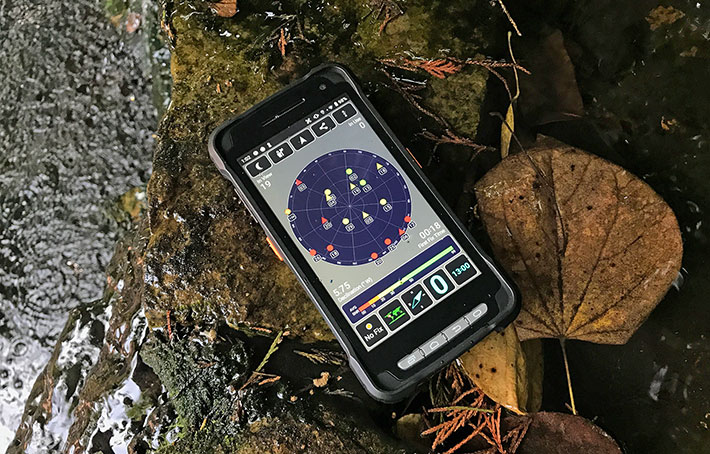
As the picture above shows, the XT3 has a modern, trendy smartphone look. And that's really the point here: with several billion smartphones out there now, most people expect a handheld computer to look and work just like their smartphone. They know how that works. They're not afraid.
The challenge with that approach is to really pull it off. If a device looks like a state-of-the-art smartphone but can't back up the look with the speed and features customers expect, it'll be seen as lacking. If it is state-of-the-art but is noticeably bulkier, again, it won't go far. So the challenge is to come up with something that has that appealing consumer tech look and feel, but also adds enough serious tool-for-the-job value to make enterprise users accept the bit of extra heft and cost that comes with ruggedness.
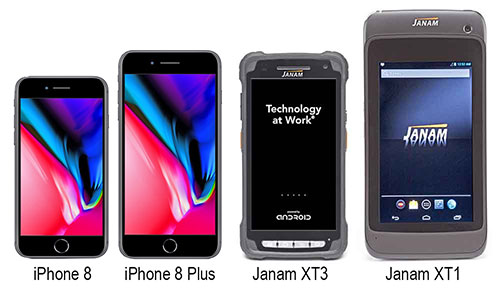 With that in mind, let's take a look at the Janam XT3. It has a 6.1 x 3.2 inch footprint, which is almost exactly that of the Apple iPhone 8 Plus. It can make that footprint magic possible despite the tough-looking protective perimeter armor because its display is a bit smaller — 5.0 inches diagonal versus the iPhone's 5.5 inches. With that in mind, let's take a look at the Janam XT3. It has a 6.1 x 3.2 inch footprint, which is almost exactly that of the Apple iPhone 8 Plus. It can make that footprint magic possible despite the tough-looking protective perimeter armor because its display is a bit smaller — 5.0 inches diagonal versus the iPhone's 5.5 inches.
The comparison picture on the right shows where the Janam XT3 fits in sizewise. Starting on the left, the 4.7-inch display of the Apple iPhone 8s would have been considered big in the early years of the smartphone era, certainly much larger than the tiny 2.8 to 3.5-inch displays used for many years on virtually all phones, Pocket PCs and industrial handhelds.
Next, the iPhone 8 Plus with its 5.5 inch screen is among Apple's best-selling models ever. The earlier iPhone 6 Plus of the same size had established the big-screen smartphone as a universal small computer that was neither just a phone nor a small tablet, but somehow more than the sum of their parts. And that is exactly where the 5-inch Janam XT3 fits in sizewise. On the right, for comparison, the Janam XT1 with its 5.9-inch screen is already in the mini-tablet territory.
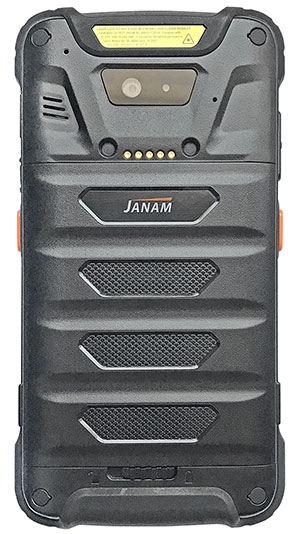 While the XT3 looks just like a regular smartphone from the front, you couldn't get all of its extra features in a package as thin and light as a contemporary phone. The extras here are a degree of ruggedness that is way, way beyond what any consumer smartphone can offer, and also the kind of connectivity and data collection technology only professional-grade gear can provide. While the XT3 looks just like a regular smartphone from the front, you couldn't get all of its extra features in a package as thin and light as a contemporary phone. The extras here are a degree of ruggedness that is way, way beyond what any consumer smartphone can offer, and also the kind of connectivity and data collection technology only professional-grade gear can provide.
The former includes a 5-foot drop spec without the nearly mandatory protective case consumer phones need. The latter includes an integrated industrial-grade N6705 1D/2D barcode reader from Honeywell. That's because on the job you don't scan inventory with the phone camera and an app. You do it with tech that was designed for fast, accurate, reliable scanning.
Then there are jobs that need RFID and NFC reading capabilities, or devices are going to be used as mobile payment stations in the field. Bottom line is that today's and tomorrow's customers expect to find a full spectrum of data capture requirements in one single tough, durable yet elegant and easy-to-use device. That's what Janam had in mind with the XT3.
Such a device also needs a replaceable battery, because out there in the field you can't just plug your handheld in and wait until it's recharged. And since you never quite know how much data you may have to store, it's good to have a card slot. The Janam XT3 has both.
As a result, the Janam XT3 can't be razor-thin. It's about 0.8 inches thick and weighs almost ten ounces. Which is still remarkably thin and light, but of course thicker and heavier than a consumer phone.
And there is Android 9, the full GMS version. It is also "Android Enterprise Recommended." To qualify for this Google certification, a device must support multiple major operating system releases, deliver Android security updates within 90 days of release from Google for a minimum of five years, and must be protected against moisture and dust intrusion. In addition, the devices must offer bulk deployment options, including the Android zero-touch enrollment option for easy setup and configuration. All good.
Janam's approach with the XT3
Unlike Janam's XT1 mini-tablet, the smaller XT3 is a true rugged handheld and not something in-between handheld and tablet. As such it must provide as much of the commonly expected consumer smartphone experience as possible, while also being much tougher than any standard smartphone, and equipped with the type of extra functionality required on the job (such as scanning, RFID, etc.)
 On the technology side of things, XT3 customers get a mix of consumer and industrial technology. The device is powered by an octa-core 2.2GHz Snapdragon SD660 processor that's part of Qualcomm's family of mobile "systems on a chip" (SoC). line. It's a fast mid-range chip especially developed for tablet and smartphone applications. It uses a 64-bit CPU architecture and runs on four ARM Cortex 73 cores and four ARM Cortex A53 cores. On the technology side of things, XT3 customers get a mix of consumer and industrial technology. The device is powered by an octa-core 2.2GHz Snapdragon SD660 processor that's part of Qualcomm's family of mobile "systems on a chip" (SoC). line. It's a fast mid-range chip especially developed for tablet and smartphone applications. It uses a 64-bit CPU architecture and runs on four ARM Cortex 73 cores and four ARM Cortex A53 cores.
For graphics, the SDS660 includes an Adreno 512 GPU that supports all the features that matter in this class of mobile computer. The processor is used in numerous smartphones, and it has also become something like the processor of choice in leading rugged handhelds and tablets.
Depending on the version, there are 3GB or 4GB of RAM and 32GB or 64GB of Flash for storage. While even 64GB doesn't seem like a lot compared to iPhones that now come with up to 512GB, the XT3 has an internal, user-accessible microSDHC expansion card slot, which iPhones don't have. So the XT3 really has 32 or 64GB onboard plus whatever is in the card slot (we tested it with a 256GB microSD UHS-I card). That sometimes means users must copy things from here to there, or specify where something should be installed.
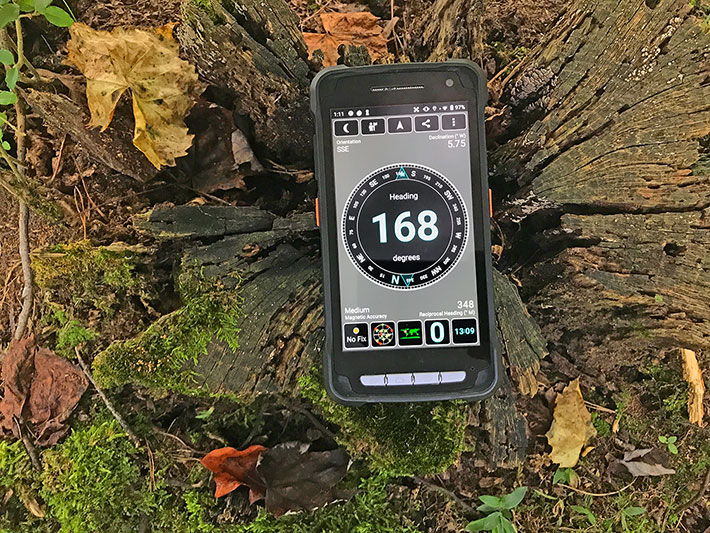
For communications there is dual-band 802.11a/b/g/n/ac WiFi, plus adherence also to the 802.11 d/h/i/k/r/v standards that handle global roaming, interference elimination, enhanced security, fast roaming, optimized network performance, power savings, and client/infrastructure protection.
Bluetooth 5 BLE (Bluetooth Low Energy) supports earlier versions of Bluetooth as well as the newer low energy protocols. Bluetooth 5 also has twice the data throughput, a long range mode (up to 800 feet), and improved connectivity.
The Janam XT3 comes with embedded NFC/RFID reading capability. For positioning there's Qualcomm IZat Gen 8 for GPS, BeiDou, GLONASS, Galileo, QZSS and SBAS. IZat supports location services that show who and what is around the device, and if it's indoors or out. Customers can specify 4G LTE, WCDMA, and EDGE/GPRS/GSM mobile broadband. A 13-megapixel autofocus camera with user-controllable LED flash can be used for both still image and video documentation, and there's also a 5mp frontfacing vidcam. Unlike most lenses under cover glass, this one remains visible at all times, which makes it easier to look into the camera during video conversations.
The XT3 has a user-accessible and easily removable 11.2 watt-hour Li-Ion battery. A more powerful 22.4 watt-hour extended battery is optionally available. Charging is either via a supplied USB-C cable to the AC/DC charger or via Janam's single or multi device docks.
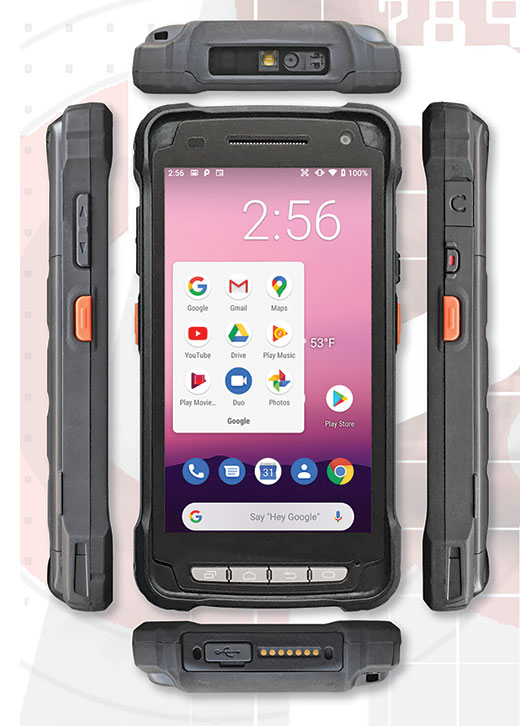 The compilation image on the right shows the Janam XT3 from the front and from all four sides. The frontview shows the 5.0-inch screen with its hardened glass capacitive multi-touch interface. The compilation image on the right shows the Janam XT3 from the front and from all four sides. The frontview shows the 5.0-inch screen with its hardened glass capacitive multi-touch interface.
The flush cover glass extends 1/8th inch beyond the LCD perimeter on the sides, and roughly half an inch on the top and bottom, making for smooth and easy operation. The glass is framed by a very slightly raised rubber border that serves both as a seal and to provide extra protection to the frontal glass.
The top view shows the unit's 1D/2D industrial-grade bar code reader window. Unlike in most handhelds equipped with dedicated scanners, the one in the XT3 does not add extra thickness.
The left side of the device shows a volume up/down rocker as well as an orange scanner button. The right side has a second orange scanner button, the small on/off/sleep button, and the unit's 3.5mm audio jack beneath its protective sealing cover.
The bottom of the unit shows the surface-mount docking and a reversible USB-C connector. If you want to sync or connect with a desktop or laptop, you need a USB-C to USB cable or the dock or both.
The XT3 has four physical buttons for the three standard Android controls (recent apps, home, and back), as well as a programmable key. The white labels on matte silver keys are not always easy to see.
Janam XT3: design and construction
Industrial handhelds have changed a lot over time. Once they were utilitarian and often proprietary tools for narrowly defined jobs. Today they are mobile computers, scanners, phones, cameras and more. However, unlike consumer smartphones with very short life cycles, enterprise and industrial mobile devices have a much longer life cycle, and they must be easy to customize, configure, service and repair.
At RuggedPCReview.com, we want to know what's inside a unit that's expected to reliably do its job for many years. So let's take a look at the interior of the XT3. The battery compartment contains not just the battery, but also the unit's SIM and SAM slots and the microSD card slot. This type of design requires a very well sealed battery compartment cover. Janam did that with a replaceable orange o-ring and a spring-loaded friction slider to securely lock the cover. It takes a bit of prying to remove the cover and some pressure to put it back in place.

The replaceable 3.85 Volt, 2,900mAh Lithium-Ion battery packs 11.2 watt-hours and is not even a quarter of an inch thick. It is encased in hard plastic, unlike those squishy batteries in cheap electronics.
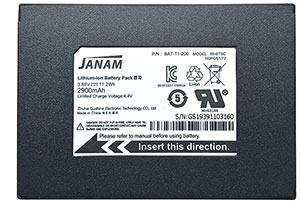 Physically, micro SIM and micro SAM cards and card slots are the same, but where SIM (Subscriber Identity Module) is for voice and data wireless service, SAM stands for "Secure Access Module" and works more like a SmartCard to handle secure transactions such as mobile payments. Physically, micro SIM and micro SAM cards and card slots are the same, but where SIM (Subscriber Identity Module) is for voice and data wireless service, SAM stands for "Secure Access Module" and works more like a SmartCard to handle secure transactions such as mobile payments.
Opening the housing of the Janam XT3 for repair or maintenance is easy. Remove four little rubber plugs to get to the four Torx T8 screws sitting in the four corners of the device. Undo those, then undo the four smaller Philips head screws inside the battery compartment. Then you can carefully take the two halves of the housing apart. Carefully, because there are several physical buttons that come loose and fall out. You don't want to lose those.
Sealing between the two halves is via a tongue-and-groove design with a thin grape-colored o-ring going around the entire perimeter. We like the use of color in such o-rings; it makes it much easier to see if they are uncompromised and in their proper place.
The two halves are made of black injection-molded flame-retarding polycarbonate PC+10%GF plastic . Rubberized protective bumpers goes around the entire unit. The front part of the housing has a magnesium frame for extra stiffness. Mounted onto that frame are the display on one side, and the motherboard on the other. Most of the circuitry is facing down onto the metal frame, presumably for thermal reasons.
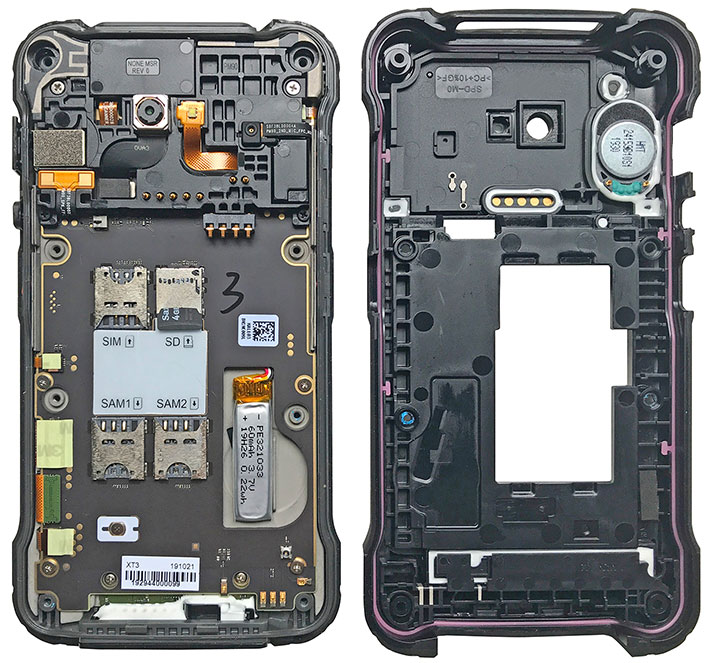
A small 3.7 Volt, 60 mAH backup battery enables hot-swapping of the main battery. A plastic subframe serves as a mounting point for all sorts of components — the camera, the LED flash, a microphone, and antennae. It is amazing how small some of these components have become. You look at the tiny camera and even smaller LED flash and wonder how such a small assembly can do very good still images and video, and the little LED is much brighter than one might expect.
Overall, the whole interior design of the XT3 is impressive, as is the manufacturing. Fit and finish are on a very high level, everything looks well thought out, and there is great attention to detail. Even the white silicon glue that seals certain areas is applied cleanly and precisely (which isn't always the case in systems that come to our lab).
Below are a few interesting details from the inside of the Janam XT3. On the left the camera, middle top a look at the silicone glue that is used to seal ports, middle bottom the small backup battery that makes the XT3 battery hot-swappable, and on the right there's a close-up of the replaceable pink rubber o-ring seal.

Very good performer
We don't have nearly as many Android device benchmark results in our database as we have for Windows devices. Android has only been around for about ten years, and until recently there haven't been many Android-based rugged handhelds or tablets. The results we do have show that due to fierce competition in the very large worldwide smartphone market, Android device performance has roughly doubled every two years, and recently even quicker. That's bad news for vertical markets where product life cycles are much longer than in consumer technology.
The rapid advance in smartphone performance makes customers expect no less from their work devices. For rugged and industrial device manufacturers this means more frequent tech updates than in the past. It also means staying as close to the state-of-the-art as possible to fend off quick obsolescence.
The table below shows a cross section of benchmark results we've run in our lab.
|
Janam XT3 Benchmarks and Comparisons
|
|
Device
|
Janam
|
Janam
|
Huawei
|
Juniper
|
Winmate
|
Zebra
|
|
Model
|
XT3
|
XT2
|
P30 Lite
|
Mesa 3 Android
|
M700DQ8
|
M60
|
|
Year tested
|
2020
|
2016
|
2019
|
2020
|
2020
|
2018
|
|
Display
|
5.0 inches
|
5.0 inches
|
6.0 inches
|
7.0 inches
|
7.0 inches
|
6.0 inches
|
|
Processor
|
Qualcomm SD660
|
Qualcomm SD435
|
Kirin 710
|
Qualcomm SD660
|
Qualcomm SD660
|
Qualcomm MSM8953
|
|
AnTuTu
|
174,961
|
25,213
|
130,667
|
175,615
|
166,986
|
81,954
|
|
Vellamo Metal
|
2,901
|
772
|
2,942
|
2,918
|
2,928
|
1,528
|
|
Vellamo Multicore
|
3,807
|
903
|
3,785
|
3,806
|
3,725
|
2,662
|
|
Vellamo Browser
|
5,615
|
1,993
|
5,804
|
5,758
|
5,346
|
NA
|
|
PassMark Mobile
|
8,722
|
2,699
|
9,114
|
5,801
|
NA
|
5,924
|
Note the large performance advantage of the Janam XT3 compared to the predecessor XT2 of just four years ago. It's not even close. Likewise, Zebra's M60 tablet, just two years old, already lags well behind this year's crop of machines. Also note that the SnapDragon SD660, for now, has become the go-to chip for rugged Android handhelds and tablets (Zebra, Panasonic, RuggON and others use it, too). But that'll likely change soon enough: The SD660 is quick now, but it's already three years old, and leading smartphones have long since moved on. On the other hand, SD660-equipped enterprise devices are as quick or quicker than last year's mid-range consumer smartphones (see the Huawei P30 benchmark), and that is likely just what consumers expect.
Very good 5-inch display and capacitive multi-touch
The 5.0-inch capacitive multi-touch display of the Janam XT3 isn't large by contemporary smartphone standards where some displays are pushing 7 inches, but it is large enough to comfortably run the variety of apps available for modern Android devices.
720 x 1280 pixel resolution translates into 294 pixels per inch. That's sharper than any of the retina iPads save one (the 7.9-inch mini Retina), much sharper than any 4K TV or monitor or "retina" desktop, but not as sharp as Janam's own XT200 that has FHD resolution and 441ppi. Handhelds for the job generally don't need the very high resolution of some of the premium consumer smartphones which now approach 600 ppi.
The display is protected by chemically strengthened Gorilla Glass 3. Janam specs describe the screen as daylight readable, offering 500 nits luminance.
The picture below show a comparison between the Janam XT3 and an iPhone 7 Plus outdoors, with both devices set to maximum screen brightness. Our test Apple 7 Plus clocked in at a maximum screen brightness of 550 nits. The XT3 display, which we measured at 475 nits, looked almost as bright. Both displays are glossy, so there are reflections outdoors. Most smartphone and tablet users have learned to live with that.
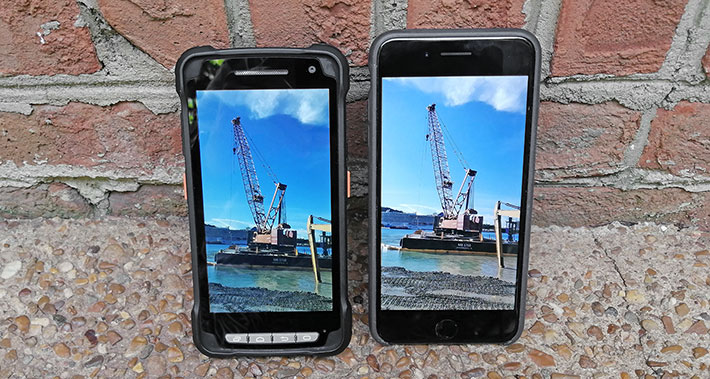
The XT3 display also sports another quality that we consider very important: very good viewing angles from all directions. That means you don't have to hold the device just so in order to properly see what's on the screen. It looks the same no matter what angle you look at it from. There are also no color or contrast shifts, which is also very important when you work with color-coded apps.
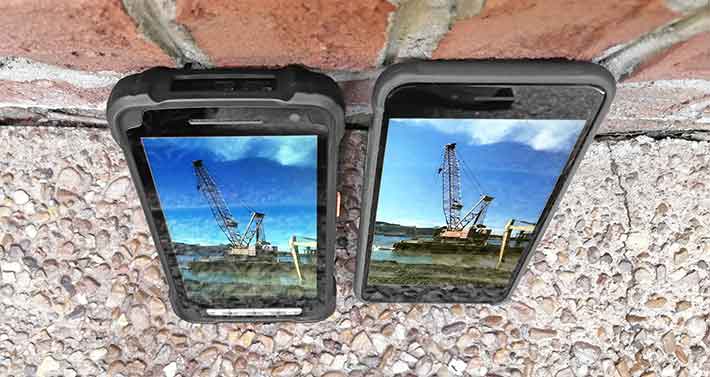
Scanning and other data capture
While the XT3 was created to be as handy and smartphone-like as possible, the device has more powerful data collection capabilities. Almost every smartphone today has cameras good enough for simple scanning via apps. But for professional speed and quality of scanning one needs a dedicated industrial-grade scanner. Our review Janam XT3 also came with demos that show how the various data collection and other advanced features work: GPS, MSR, NFC, Ping, Print, SAM and Scan.
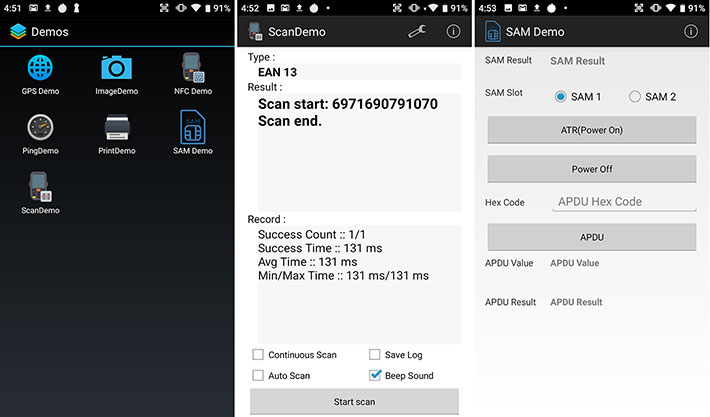
Scanning is likely of primary interest to many XT3 customers. Our test unit came with an optional integrated industrial-grade miniature scan engine from Honeywell. 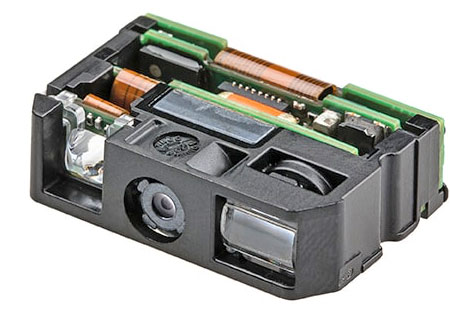 The N6703 1D/2D imager (see N670x info) is tiny, measuring just 0.27 x 0.93 x 0.64 inches and weighing barely more than a tenth of an ounce, which is why there isn't a scanner bulge on the XT3. The N6703 1D/2D imager (see N670x info) is tiny, measuring just 0.27 x 0.93 x 0.64 inches and weighing barely more than a tenth of an ounce, which is why there isn't a scanner bulge on the XT3.
The N6703 has a red aiming LED crosshair and can handle anything from total darkness to bright sunlight. It's fast enough to capture virtually any 1D or 2D bar code in milliseconds. Our XT3 came with a ScanSetting utility to configure the scanner for whatever job it's intended to be used. Below are some sample scan configuration screens:
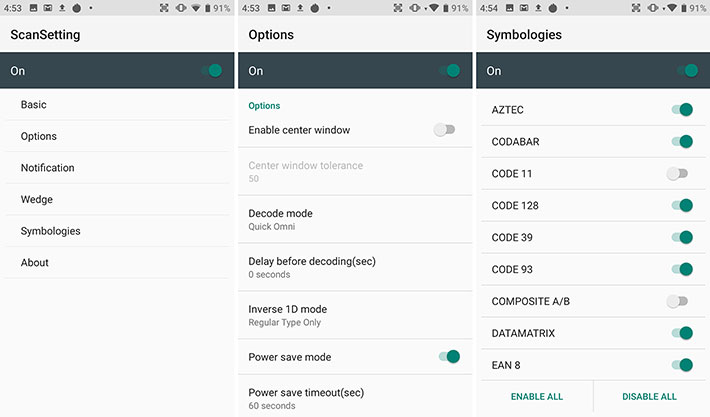
What all this means is that for XT3 customers, there's not only the proverbial "app for that," but also the dedicated hardware to make those data capture apps work at a professional level.
Competent cameras for documentation work
Nobody saw it coming, but smartphones have replaced point & shoot cameras, and they are increasingly being used even for serious photography. As a result, today's professionals and field workers expect their handheld to be able to shoot pictures and video good enough for work. Which means that devices like the XT3 must have cameras good enough for the job.
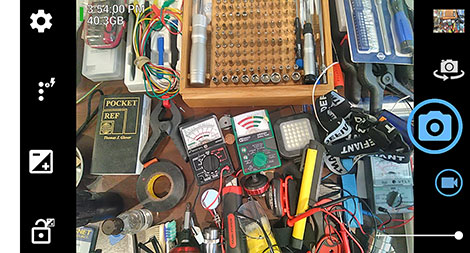 Like almost ever handheld or tablet today, the XT3 has both front and rear cameras. The 5mp user-facing camera is for video calls. The rear-facing camera is for visual documentation of job conditions, repairs, project status and the like. Its maximum resolution is 13-megapixel, and it captures pictures with up to 4,160 x 3,120 pixel resolution. 13-megapixel is what you get in premium smartphones. Both cameras can be used for stills as well as for video. Like almost ever handheld or tablet today, the XT3 has both front and rear cameras. The 5mp user-facing camera is for video calls. The rear-facing camera is for visual documentation of job conditions, repairs, project status and the like. Its maximum resolution is 13-megapixel, and it captures pictures with up to 4,160 x 3,120 pixel resolution. 13-megapixel is what you get in premium smartphones. Both cameras can be used for stills as well as for video.
In the past, the performance of cameras integrated into rugged vertical market handhelds and tablets was underwhelming. A few years ago, even the best lagged behind what was available in inexpensive point & shoots. Fortunately, this is now changing due to customer demand and the availability of much better camera modules for handhelds.
In our testing, we found the rear-facing documentation camera of the Janam XT3 to be very competent. The sample pictures we took were suitable for all but the most demanding documentation tasks. Most shots came out fine on the first try, the camera was quick, color was very good, and camera didn't over-compress images. It was also remarkably good at focussing on the right subject rather than wandering off.
The screen snap above shows the free Open Camera app that we downloaded from the Google Play Store. The interface of the default Android camera is very basic, with just +/-2EV exposure control, three flash modes, and six picture sizes from 1 up to 13 megapixels. That's not enough for the very good camera hardware. Most users will want to download one of the many camera apps from the Google Play Store.
The pictures below were shot with the Janam XT3 in 13mp mode. Click on the image to bring up a full-size version.
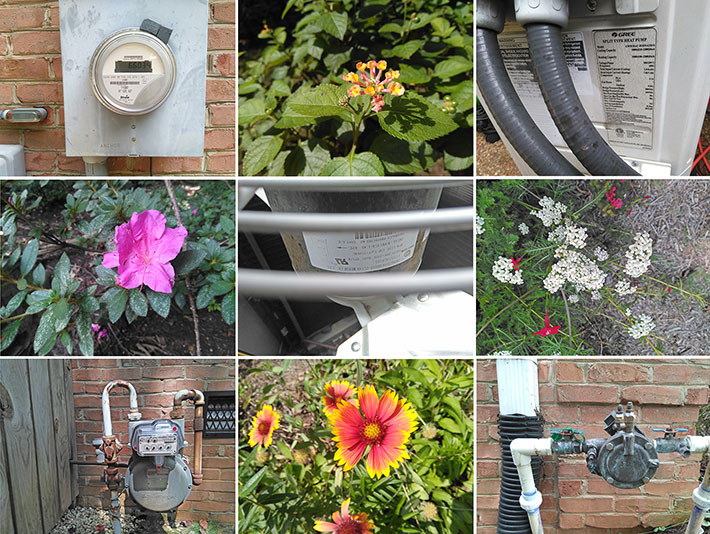
What's important here is that the rear camera of the XT3 is absolutely good enough to use for image and video documentation on the job. There's hardly any need to take a long a dedicated camera or use one's smartphone. There is very good sharpness and image detail, and the focus is quick and precise. And there's little of the massive image compression that often renders pictures from such integrated cameras useless.
Video is also significantly better than what one could expect from cameras integrated into rugged devices just a year or two ago. Frame rate and focussing are quick and the camera doesn't fall behind. Even 4K video worked flawlessly. The 5mp front camera is also quite good (it can do 1080p video), and both cameras have digital zoom.
Overall, the still image and video quality of the Janam XT3 are much better than average and definitely good enough for most documentation jobs.
Truly tough and rugged
Ruggedness separates devices designed to withstand the perils and conditions of work in the field from consumer smartphones. Yes, consumer phones can be placed in a protective case or a sleeve that adds functionality such as longer battery life or a dedicated scanner. But those are afterthoughts that may or may not get the job done. Leading smartphones are water-resistant now, at least to a certain extent. But that is still far from being rugged.
Ruggedness comes at a cost. Extra components cost, extra protection costs, and a rugged device will be thicker and heavier than a consumer product. Yet, in order to appeal to customers used to light and slender smartphones, ruggedized handhelds must be appealing enough to be accepted, and they must not be too bulky or heavy.
So what degree of ruggedness did Janam bake into their rather attractive XT3? We already reported on build quality and structural design. But what about this handheld's ruggedness specifications?
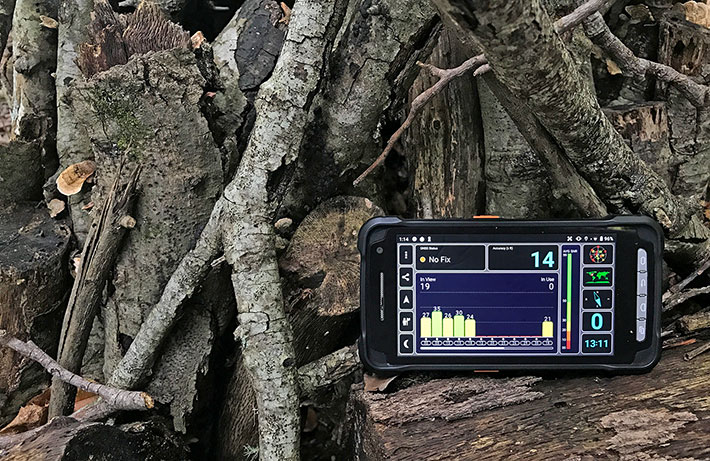
First, the Janam XT3 carries IP67 sealing where the "6" means it is totally protected against dust, and the "7" means that it is also protected against the effects of full immersion in water down to a depth of one meter (3.3 feet). That makes the XT3 invulnerable to dust and liquids. It can be used the rain, even in a down-pour. And if it falls into a puddle or even a shallow stream, no problem. That said, many modern consumer phones, which are much easier to seal, are now IP68 rated, which means they are completely waterproof even at longer deeper immersion. So IP67 is no longer as special, but for most applications it's good enough.
Note that capacitive multi-touch and water generally don't get along because the technology relies on measuring capacitance between touches. Janam addressed that to some extent with a display surface that makes liquids pearl into tiny drops, making multi-touch possible even in the rain. Gloves are another problem with capacitive multi-touch, but the XT3's touch controller is sensitive enough to allow working with thin gloves.
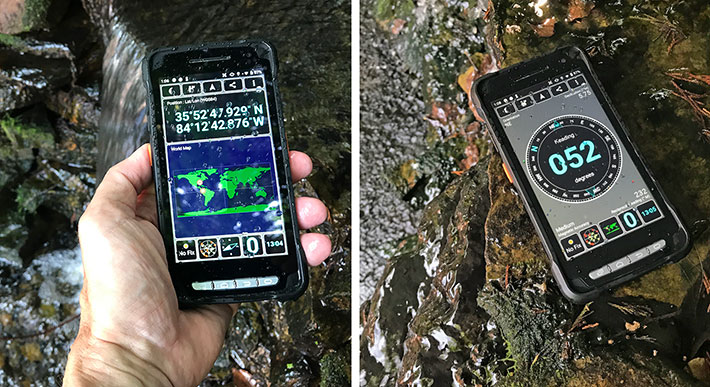
The device can handle multiple drops from five feet to concrete. When it comes to mobile computers that are used while being carried around — such as tablets and handhelds — you want for them to be able to survive drops of four feet, because that is about as far as they'll fall. You also want for them to survive those falls no matter what they hit and in what position they make impact. And no matter how hot or cold it is. The XT3 was tested for all that.
The unit's operating temperature range of -4 to 140 degrees Fahrenheit (-20 to 60 degrees Celsius) is wide enough to allow the device to be used almost anywhere. That's important because mobile devices may encounter very high temperatures in vehicles or sitting in the sun, or very low ones if they are inadvertently left in an unheated environment.
Janam specs also state vibration testing at an amplitude of 2MM from 10Hz to 33Hz in all three axes, one hour per axis, but there's no reference to which tests were performed. It'd be good to know specifics. In addition, we've found YouTube videos of the device being subjected to extreme abuse, with no adverse effects.
Our overall impression is that the Janam XT3 is well capable of withstanding extreme environmental conditions without additional protection or fear of failure.
Summary: Janam XT3 — well-executed smartphone-style rugged touch computer with very good performance
With their XT3, Janam offers customers a massive performance upgrade over the XT2 and XT2+ predecessors. For now, the XT3 is at the leading edge of rugged mobile Android device performance. It is quick enough to please smartphone users spoiled by rapid technological advance, and that can make or break a deal.
Like all of Janam's mobile computing hardware, the XT3 is a device that caters to the needs of customers who use their devices at and for work. That means ruggedness and durability that goes far beyond what consumer smartphones can offer. It means industrial-grade components such as an integrated Honeywell 1D/2D barcode reader module rather than just using the internal camera with a scanner app as consumer devices usually do.
The sharp, bright 5.0-inch capacitive multi-touch display of the Janam XT3 is big roomy enough for the job without making the ruggedized device too big or heavy. The device is thicker and heavier than a consumer phone, but its footprint is no bigger than that of a current smartphone, and most people can easily hold and use it in one hand. The battery is replaceable, which is always good in a device used in the field.
There's integrated GPS, NFC/RFID reading, and mobile broadband. There's the integrated industrial-grade 1D/2D imager for bar code reading. The dual cameras (13mp and 5mp) are among the very best we've seen in rugged devices. And there's a modern USB-C port.
The device is elegant, well designed, and meticulously finished. It's also fully rugged and carries IP67 sealing, which means it won't even mind a drop into a puddle or stream.
What does all that make the Janam XT3? Back when we reviewed the predecessor XT2, we called it "an attractive choice for any enterprise seeking to deploy and manage smartphone-style Android-based handhelds with industrial durability and data collection technology." The XT3 is still that, but now it's a whole lot faster and more powerful.
-- Conrad H. Blickenstorfer, September 2020
Janam XT3 Specifications:
| Added/changed |
Added 01/2020, full review 09/2020
|
| Type |
Rugged handheld
|
| Processor |
2.20GHz octa-core Qualcomm Snapdragon SD660
|
| Graphics |
Adreno 512 GPU
|
| OS |
Android 9 (Pie) with Google Mobile Services (GMS); OS upgradeable; Android Enterprise Recommended
|
| Standard/Max RAM |
3GB or 4GB RAM |
| Disk/drive |
32GB or 64GB ROM onboard, plus microSDXC card storage (worked fine with 256GB card) |
| Display type |
TFT LCD with Gorilla Glass 3, outdoor-viewable |
| Display size/resolution |
5.0" WXGA (1280 x 720 pixel) |
| Display luminance |
500 nits (RuggedPCReview measured: 475 nits)
|
| Digitizer |
Projected capacitive multi-touch |
| Keyboard/keys |
Onscreen keyboard, 4 hard keys (home, menu, back, user-programmable)
|
| Navigation |
Touch
|
| Expansion slots |
1 x microSDHC Card (user-accessible), 1 X micro SIM, 2 x micro SAM
|
| Housing |
Polymer plastic
|
| Size |
6.1 x 3.2 x 0.8 inches (156 x 82 x 21 mm)
|
| Weight |
9.5 oz (272g) incl. battery
|
| Operating temperature |
-4° to 140°F (-20° to 60°C) |
| Ingress protection |
IP67 (totally protected against dust; protected against full immersion to 1 meter) |
| Humidity |
95% non-condensing |
| Drop |
Multiple 5ft / 1.5m drops to concrete on all sides across a wide temperature range per MIL-STD 810G |
| Vibration |
2MM from 10 to 33Hz in all three axes, 1 hr/axis |
| Radio |
FCC; IC; GCF & PTCRB; CE |
| Safety |
CSA C22.2 No.60950-1-03; EMC; RF; SAR; LED |
| Tumble |
500 cycles (1,000 hits) from 1 meter (3.3 feet) |
| ESD |
+/-15kV air; +/-8kV contact |
| Intrinsic safety |
NA |
| Power |
3.85V, 2,900mAh, 11.16whr rechargeable Li-Ion battery (5,800mAH optional); 3.7V, 60mAH backup battery |
| Data capture |
Honeywell N6703 1D/2D imager, RFID/NFC |
| Camera |
front-facing: 5.0mp Galaxy Core GC2355; rear-facing: 13.0mp Samsung S5K4H5 auto-focus with user-controllable LED |
| GPS |
Qualcomm IZat |
| Sensors |
Accelerometer, light sensor, proximity sensor, gyroscope, digital compass |
| Wireless |
Dual-band 802.11 a/b/g/n/ac/d/h/i/k/r/v fast roaming, 2x2 MU-MIMO technology WiFi, Bluetooth v5.0 (BLE), WWAN (4G LTE FDD and TDD, WCDMA, EDGE/GPRS/GSM: 900/1800/850/1900), GPS and A-GPS |
| Interface |
USB-C 3.0 OTG, 3.5mm audio in/out, dual microphone |
| Price |
Inquire |
| Spec sheet |
 Janam XT3 brochure (PDF) Janam XT3 brochure (PDF)
|
| Web page |
Janam XT3 web page |
| Contact |
Janam
999 South Oyster Bay Rd, Ste. 409
Bethpage, NY 11714
1-877-JANAM-99
www.janam.com
|
|






